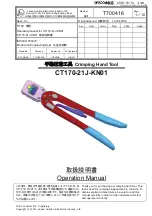
EK12IDL Battery-powered, Dieless Crimping Tool
Greenlee / A Textron Company
4455 Boeing Dr. • Rockford, IL 61109-2988 USA • 815-397-7070
2
Description
The EK12IDL Battery-powered, High-speed Crimping
Tool is a hand-held, self-contained, dieless crimping tool
intended to crimp aluminum and copper connectors
onto electrical cable.
This tool has a retraction stop feature which allows the
operator to stop the retraction motion of the ram to
shorten cycle time.
This tool is protected by U.S. Patent No. 6,206,663,
6,276,186, 6,401,515, and 6,718,870.
Safety
Safety is essential in the use and maintenance of
Greenlee tools and equipment. This manual and any
markings on the tool provide information for avoiding
hazards and unsafe practices related to the use of this
tool. Observe all of the safety information provided.
Purpose of this Manual
This manual is intended to familiarize all personnel with
the safe operation and maintenance procedures for the
following Greenlee tool:
EK12IDL
Battery-powered, Dieless Crimping Tool
Keep this manual available to all personnel.
Replacement manuals are available upon request at
no charge at www.greenlee.com.
Do not discard this product or throw away!
For recycling information, go to www.greenlee.com.
All specifications are nominal and may change as design
improvements occur. Greenlee Textron Inc. shall not be liable for
damages resulting from misapplication or misuse of its products.
GATOR is a registered trademark of Textron Innovations Inc.
Blackburn is a registered trademark of Thomas & Betts.
KEEP THIS MANUAL
Table of Contents
Description ..................................................................... 2
Safety ............................................................................. 2
Purpose of this Manual .................................................. 2
Important Safety Information ..................................... 3–4
Identification ................................................................... 5
Specifications ................................................................. 5
Operation .................................................................... 6–7
Connector Selection ....................................................... 8
Maintenance ................................................................... 9
Troubleshooting ............................................................ 10






























